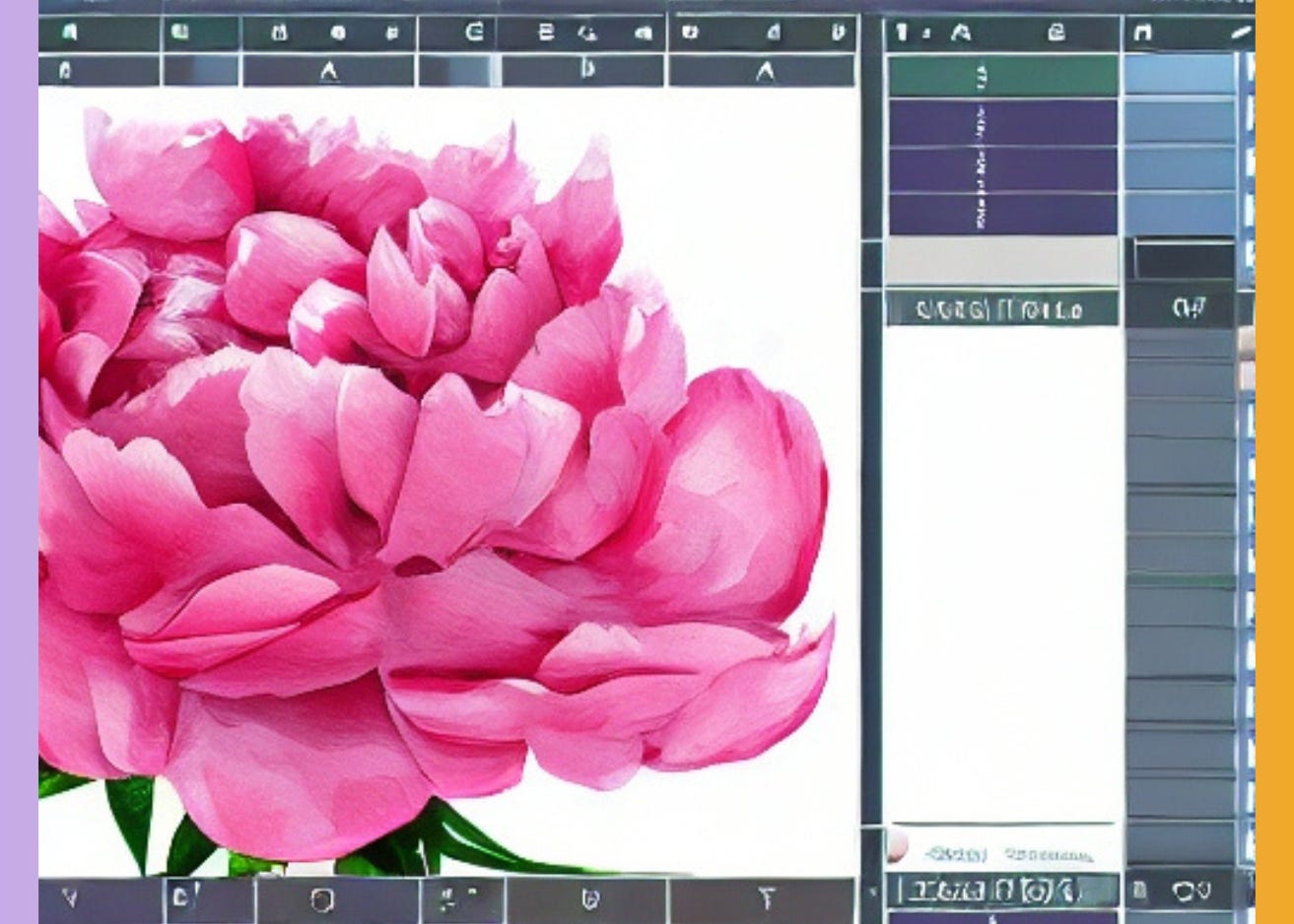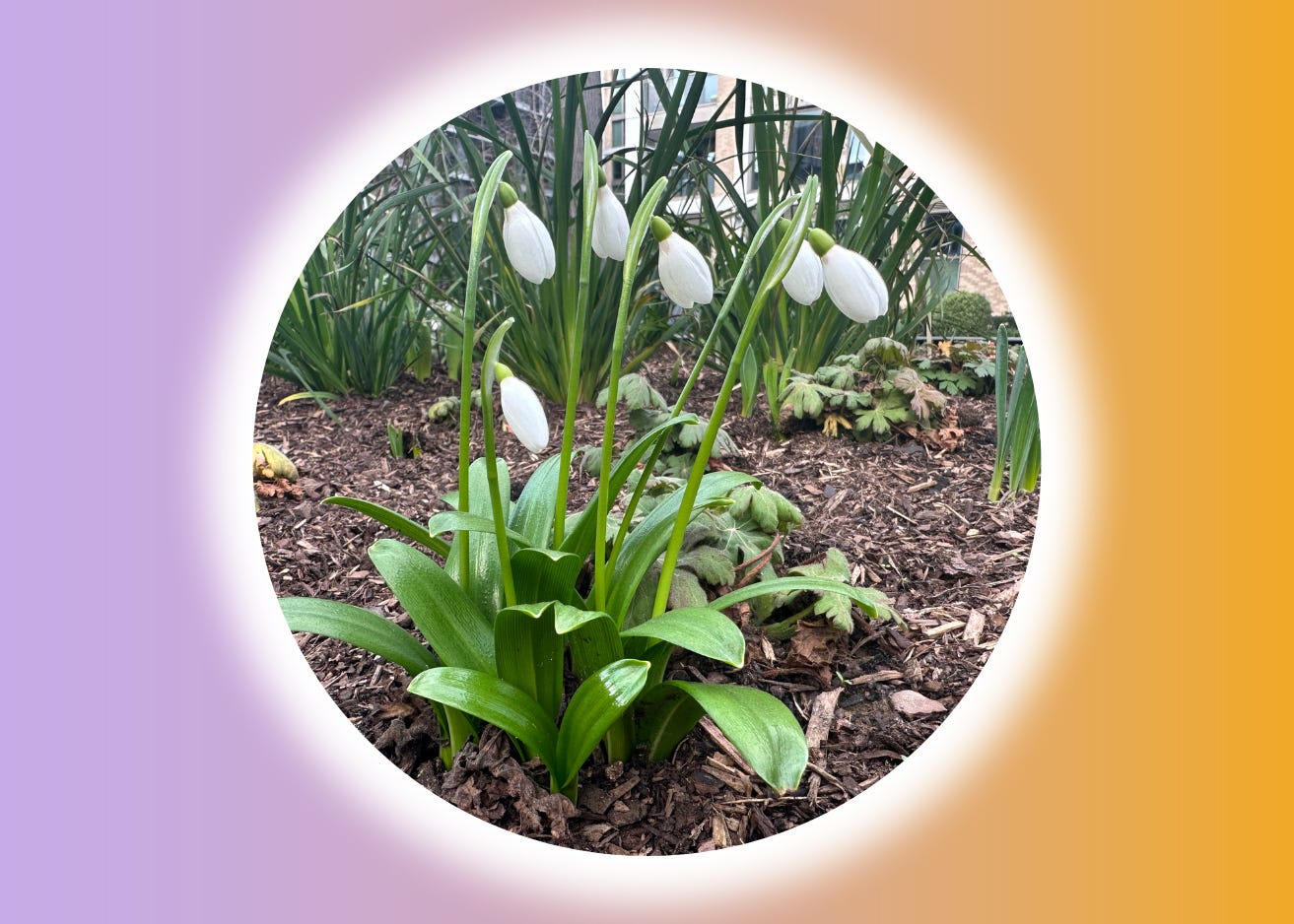An ode to pretty work, part I 💐
Why going the extra mile matters and how to get there.
I was in London last week - a city that is as beautiful as it is intense. Coming from the much smaller Amsterdam, the energy change is palpable. More of a 24/7, black coffee tea, grind-and-hustle vibe. This a broad generalization, but it's hard to walk past the modern offices and crowded Tube stations without thinking: this city is on the MOVE.
But then, across the street, I spied a very Professional Business Human™ slowing their Professional Business Human Walking Pace™ to stop at a sidewalk planter. I was momentarily worried they were going to put out a cigarette in the plants, but no! They smiled a cute lil’ human smile and took out their phone to grab a photo of these delicate flowers:
After getting a few good angles, they strode off (with a detectable spring in their step), while I crossed the street to experience them for myself. They were worth the stop.
We know that beauty and aesthetics hold so much power. Green spaces in cities support children’s development. Making and experiencing art supports IQ, lower stress levels, and even reduces pain.
That’s all great - but I love the power it has to simply make us ✨happy.
How cute is it that we’re all out here, hanging out on this little blue marble, looking at the stars, taking artsy photos of our coffee, crossing the street to take a photo of beautiful flowers. We do these things just because they’re lovely. 🥹
Pretty things are soothing and enjoyable. And those are words that we’d love to see more of at work, right? Just imagine sidewalk-flower-spring-step being the mood from 9-5.
Now, I know that breathtaking feeling of receiving a bouquet isn’t exactly what most of us get to do for work. But you can still foster this feeling for yourself by making time and space for pretty work and pretty workspaces. If for no other reason than to have some joy and beauty around you for 40 hours a week. 💜
We’re splitting this topic into two editions - I (Pretty Work) and II (Pretty Workspaces). Jade will be back in your inbox next week with part II!
So, What’s Pretty Work?
Yeah, so - the excel spreadsheet you’re working on? It probably doesn’t look like a peony and never will. That’s ok. You will have your own version of “pretty” work and it is worth discovering for your own satisfaction and wellbeing.
However, pretty work can also positively impact your career. And that’s because:
Humans like humans who care, and humans like pretty things.
Therefore, if you’re a human who creates pretty things with care, you will have a vastly different experience at and with your work.

So, if you aren’t a graphic designer, or an AI, or a florist, what might your version of a stunning deliverable look like?
Pretty work is really just work that has clarity - clarity of purpose and clarity of process.
In other words - can what you create be nice to interact with and easy to use for the next human that encounters it?
So, how do you make your purpose clear? Purposeful visuals.
And how do you make the process clear? Direct direction and directions.
(I know. Bear with me!)
If you can give your work these two things, you’ll not only have a much better experience creating it, but also in how other humans interact with it/you.
When those humans sense that you care, really care, and that you have thought about what THEY need - there’s a whole new world open to you. This is more than just doing stuff. Creating a sense of ownership and care in your work is your craft. And when you share your craft with your people (peers, managers, clients, team), it builds lasting trust.
Part 1: Purposeful visuals
As all of us who went crazy with highlighting our entire books back in the day know that more is not necessarily…more. “Purposeful visuals” means designing your work in a soothing and clear way. It’s why advertisements bold certain phrases, and why books use nice line spacing - it looks great, yes, but it’s also meant to help you experience and use it well.
Besides “nice to look at / easy to use,” there are a few other reasons to adopt pretty work as your modus operandi:
Humans love beauty, remember? They will prioritize you and your work if it looks nice. So, want your work reviewed first, or do you want to be first in line for their attention? Make your work pretty.
Humans love their brand. This is especially true if you work in a client/customer-facing business. You automatically win by using their names, visuals, colors, etc., instead of your own. Center them, not you.
Humans love finished products. Work delivered in a crisp deck versus in a document named “draft” written in Calibri will feel more complete. You’ll get more actionable feedback from whoever receives it, too, as they think it is further along.
Keep in mind, there are SO many types of work we as humans create outside of desk work (bouquets, dishes/recipes, classroom activities, repaired bikes, lattes, a yoga flow, etc) and all of them have value. To keep this newsletter brief, we added some other examples and tips on visuals in the Pretty Work guide (on our new website!) Comment below with your examples - we’ll add them to the next version of the guide 🙏
Part 2: Direct direction and directions
This section is about the experience with your work. Namely, the journey of your creation AFTER you’re done with it. Who is it for? Who needs to understand it? Who may see it, and what context will make it easier for them to use it?
The key to this is directness, both in how and where it should go (direction) and how it should be used (directions)!
Direct direction
If pretty work is like a bouquet of flowers, indirect direction is when you just miss the delivery person.
Let’s use the oh-so-common example of file sharing to illustrate this one. 🫠 Even within companies, everyone has a different system and preference for how to “get” work.
Some people share directly from Google Drive or Microsoft OneDrive. Some people cannot and will never open a Microsoft OneDrive file. Some people work on documents offline in Microsoft Office or Keynote/Docs/Numbers. Some people refuse to give either corporation their money, so they use free tools like Libre Office. Some people work in any of these systems, yet prefer to share files only as email attachments. Some people want printed versions only. The individuality goes on!
So when it comes time to share something - most people share from the system they use. That’s “pretty” to them, as its a seamless process from crafting to sharing.
But to really stand out, how can the process be seamless for whoever is receiving it? Use their preferred file type and how they like receiving info. If that’s an attached word doc file in an email, click “download - .docx” in your Google Drive and go for it. This shows you’ve thought about their experience with your work and it’s more pleasant for both of you. (Especially since you don’t need to sit on email to re-send, relink, re-tag, etc., whatever it is you’ve created for them).
In other words - the flowers arrive on time and are easy to receive! 💐
Direct directions
Indirect directions is like when someone leaves flowers at your door, but the note has been rained on, so you can’t tell who it’s for, or maybe it’s for you, but if it IS for you, you have no idea who to thank, so you have to go on this Nancy-Drew-investigative-journey to figure out indeed if it was for you and what to do with it. 🫠
In other words: Picture the journey your work will take once you send it along - like a game of telephone. Who else is going to see or hear about your work? Who might THAT person send it to or talk about it with? Do they know who you are? Would they know from your creation, document, plan, etc., what it is and why they have it or are hearing about it?
Now imagine they’ve just come back from a two-week holiday or have had the craziest day and have only a few minutes for your project. What can you do that makes their lives easier? You spending two minutes could save them twenty - truly.
Easy things to do:
If it’s a file, make the name of the file clear. No “final_final_final_v3” here! Name of the document, date created, whether it's final, for review, draft, etc.
Give clear directions - in email and in the document itself - what is it, and how should it be used?
Always find a way to summarize the goal or objective of the project - especially if you are in a business where you provide work to clients or customers. Put a short summary within the document if you can; otherwise, make sure it's in your email, so there's something there when the chain is forwarded along!
If you’ve written an email for someone to send, include a subject line. I love this one - extra mile sparkle.
The flowers are signed, sealed, and delivered - and they came with super helpful directions for care. What a nice way for our fellow humans to show up in our lives. 😌
We pulled some other examples of what this “direct direction and directions” work can look like IRL in the guide I linked above - here it is again for you!
TL;DR: Making things pretty and easy to use is worth doing. It strengthens your career. It helps you show up for other humans, which hopefully means they show up for you. Most importantly - you have shown up for yourself.
Go create something you’re proud of!
Kindly,
✨ Rachel
Links We Love
Great articles to read about beauty, awe and aesthetics. What else should we be reading? Comment below!
📰 Articles
How a Bit of Awe Can Improve Your Health
Why Is Beauty Important to Us?
Redesigning Art and Science in Daily Life
(A supremely cool article by Hitachi on the importance and power of aesthetics to create meaning)
Aesthetics and beauty in philosophy
A review of the philosophical work on this topic courtesy of Stanford University. A great resource for remembering that, yep, beauty is important and has been the subject of much discussion throughout human history!




